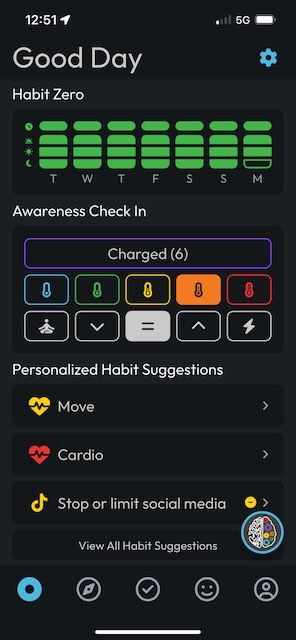
The New Habit Loop (willpower not required)
I just finished reading The Hunger Habit by Judson Brewer, and I think he’s hit the nail on the head on what it takes to change a habit.
His approach is quite fascinating, and it’s nice to finally have some science backing up what I’ve been saying all along.
While his book focuses on eating habits, the principles can be applied across all behaviour changes.
He even goes so far as to state that you don’t need willpower to change a habit.
Before I share the secret to changing habits (without willpower), let’s discuss how the brain processes habits.
The Structure Of A Habit
If you’ve spent time learning about habits, you’ve probably come across the following basic structure of a habit.
Trigger > Behaviour > Reward
- A trigger is an internal or external cue that initiates the behaviour.
- The behaviour is the automatic action that we perform.
- The reward is the immediate dopamine hit that wires in the habit right after we execute the behaviour.
The Willpower Problem
The problem with this model is that it relies on willpower to change a habit.
We’ve all heard the standard habit advice to strengthen your willpower to change your habits (I’ve been guilty of it).
The problem with willpower is …
- When we try to restrict something, we actually increase our desire to want it more.
- What you resist persists. Every time we try to resist something using willpower, we actually strengthen the habit.
- When we fall off the wagon and almost always will, we backslide, indulging in the unwanted habit even more.
- As we will learn, willpower is not even part of how the brain determines what habit to run next.
The New Habit Loop
A more complete structure of a habit would look like this …
Prediction > State > Behaviour > Reward > Impact
Prediction
Our brains are habit creation, execution and prediction machines.
Our safety brain and nervous system constantly scan the environment, looking for threats and sending signals to the habit brain to trigger the behaviour with the highest expected reward value.
A number of factors determine the expected reward value, the main one being keeping you safe.
This means that the secret to changing habits is to figure out how to decrease the expected reward value of the habits we don’t want and increase the expected reward value of the habits we do want.
State
When our safety brain triggers a habit, it starts the habit loop by sending a cocktail of neurotransmitters throughout our nervous system.
The result is a state.
A state is a combination of our thoughts, feelings and physical sensations in response to a trigger.
This is a critical distinction.
A trigger is not something that happens in our heads. It happens in our bodies.
We’ve all felt the intense feeling of anger or the rush of anxiety moving through our bodies.
This is the brain preparing our mind and body to predict the best possible outcome in a given situation.
Behaviour
Every behaviour you’ve ever learned is stored in your habit brain.
This is both a blessing and a curse.
It’s a blessing because we don’t have to relearn how to walk or any other part of our regular routine each day.
It’s a curse because once a habit is learned, it requires a lot of energy to change.
Reward
Once we execute the behaviour, our safety brain compares the expected reward value with the immediate result.
This closes the encoded habit loop.
If the expected reward value matches the immediate results, we get a little squirt of dopamine that wires in the habit.
If it doesn’t match, we get a huge squirt of dopamine to single our safety brain that there is something to learn.
Impact
When it comes to changing habits, this is where the magic happens.
The key to changing any habit is simply paying attention to the long-term impact of our behaviour.
Instead of using willpower to prevent the habit from being triggered, we let the habit run and use our thinking brain to assess its long-term impact on our lives.
When we repeatedly pay attention to our habits in this manner, the safety brain revaluates the expected reward value of the habit and adjusts it accordingly.
Each time we do this, we build up a history of negative experiences associated with the unwanted behaviour.
Instead of using force or control to change our habits, we partner with our brains using curiosity, awareness and non-judgement.
According to science, we can expect to see results in as little as 21 days.
This is the Mindful Habits Strategy I’ve used over the last nine years to personally install over 100+ habits.
And we now have the science to back it up.





